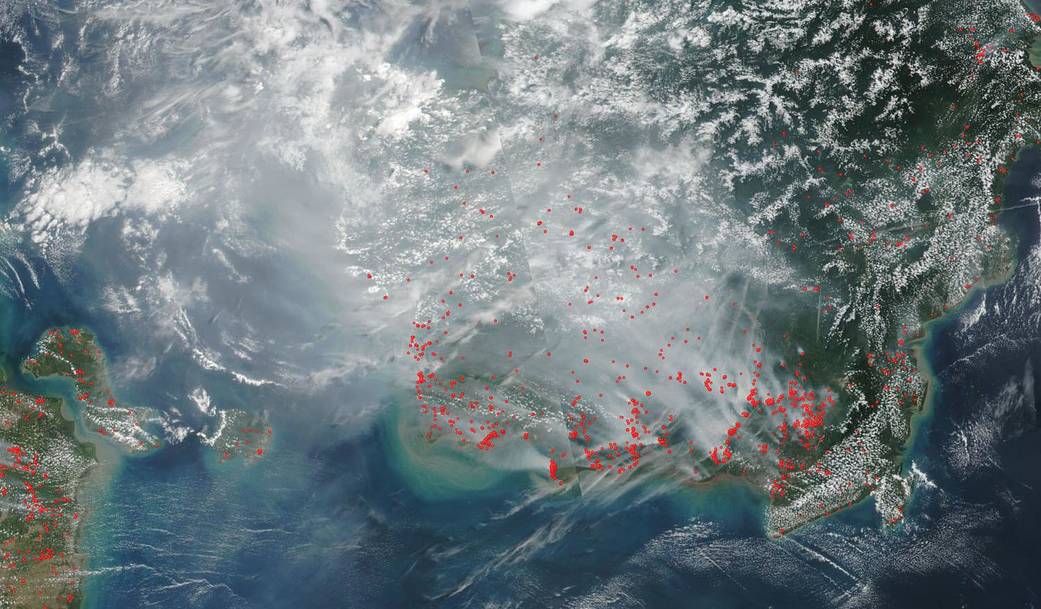Heavy smoke hangs over the Indonesian islands of Bangka and Belitung as well as Kalimantan. This thick smoke comes from the peat fires that have engulfed these islands. On September 11, 2019, NASA/NOAA’s Suomi NPP satellite using the VIIRS instrument (Visible Infrared Imaging Radiometer Suite) captured this dramatic photo of the smoke rising from these islands in Indonesia.
During the week of Sep. 3, 2019, the Global Forest Fire Watch website detected 636 fires on Bangka and Belitung. On Kalimantan the three provinces that are seeing the most fire activity are Barat, Selatan, and Tengah. Barat has seen 12,516 fire alerts during the week of Sep. 3. Selatan saw a total of 1,946 fire alerts and Tengah saw 14, 936 alerts. These fires are causing huge smoke plumes to rise over the islands. There are large peat swamp forests in Indonesia. Carbon is withdrawn out of the natural cycle and converted into peat through a biological process. These peat forests represent a major ecosystem in Indonesia and range between 16.5–27 million hectares (40.7 – 66.7 million acres) in size. According to Stanford [University] News: “‘Although they only cover 3 percent of the world’s land area, peatlands are estimated to contain 21 percent of the world’s soil carbon,’ said Stanford University doctoral candidate Nathan Dadap, lead author on a new study correlating soil moisture with fire vulnerability in peatlands.” This study used NASA’s Soil Moisture Active Passive (SMAP) satellite to measure soil moisture in Southeast Asia. The importance of measuring this moisture is that once burned these stores release that carbon into the atmosphere which contributes to the already precipitous ongoing climate change.
In addition to the climate change issue, a more immediate problem is the highly toxic smoke produced by these fires. The smoke released by any type of fire (forest, brush, crop, structure, tires, waste or wood burning) is a mixture of particles and chemicals produced by incomplete burning of carbon-containing materials. All smoke contains carbon monoxide, carbon dioxide and particulate matter (PM or soot). Smoke can contain many different chemicals, including aldehydes, acid gases, sulfur dioxide, nitrogen oxides, polycyclic aromatic hydrocarbons (PAHs), benzene, toluene, styrene, metals and dioxins. The type and amount of particles and chemicals in smoke varies depending on what is burning, how much oxygen is available, and the burn temperature. All of which are dangerous to breathe and in high concentrations can be extremely hazardous to people’s health and more so for the young and elderly.
NASA’s Earth Observing System Data and Information System (EOSDIS) Worldview application provides the capability to interactively browse over 700 global, full-resolution satellite imagery layers and then download the underlying data. Many of the available imagery layers are updated within three hours of observation, essentially showing the entire Earth as it looks “right now.” This satellite image was collected on September 11, 2019 by NASA/NOAA’s Suomi NPP satellite using the VIIRS instrument (Visible Infrared Imaging Radiometer Suite). Actively burning fires, detected by thermal bands, are shown as red points. Image Courtesy: NASA Worldview, Earth Observing System Data and Information System (EOSDIS). Caption: Lynn Jenner with information from Stanford News and the Global Forest Fire Watch website.



























